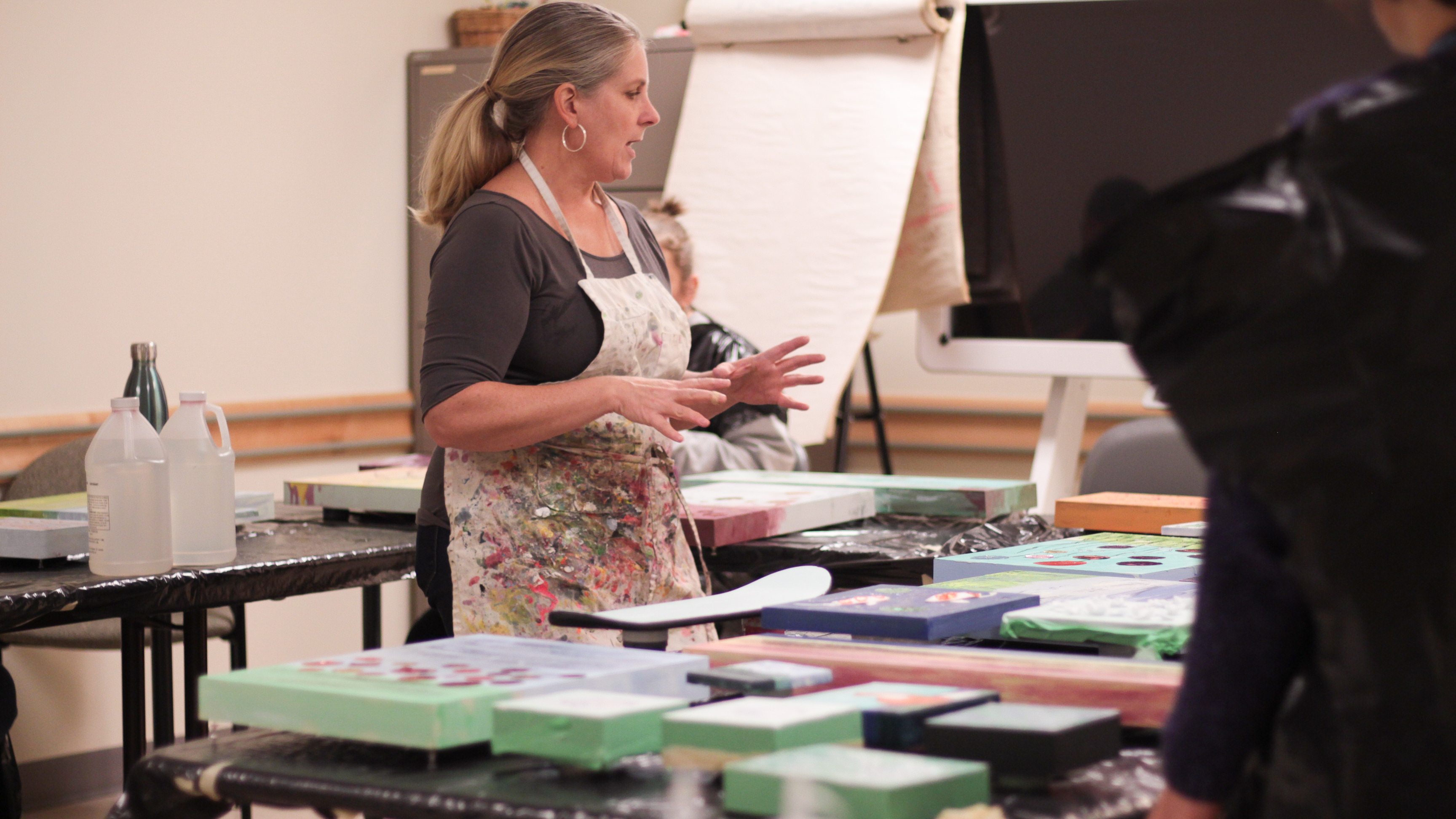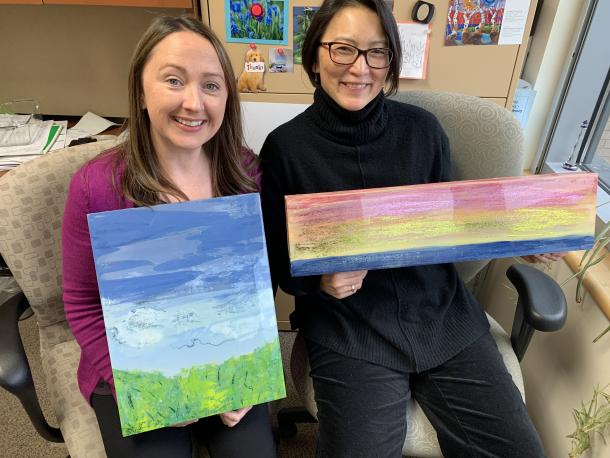Sarah Moffat stands in the middle of a room of plastic-covered tables arranged in a “U” shape around her, holding a brightly painted panel of wood in one hand and a sanding block in the other. She leans the panel against her leg and shows a keen but small audience how to smooth the edges before proceeding to the next step in the process.
Moffat is a professional multimedia artist. Her apron – now covered in a dusty rainbow of paint splatters – betrays the evidence of countless creative projects. Usually she works and teaches out of her studio in Carleton Place but today she’s helping members of The Royal’s Integrated Schizophrenia Recovery Program art group create something truly original.
Art group is open to clients in the schizophrenia day and outpatient programs. It’s one of a long list of client groups, which change year-to-year but generally include groups such as Leisure Outing, Cooking Group, Ready Set Work, and Creative Solutions.
Today, the six members of art group – as well as a few staff members – are adding extra flair to panels they painted in a free flowing abstract style during the first of three weekly sessions with the artist.
“When you’re really conscious of what you’re doing, there’s no chance for those negative thoughts to come in – or worry about what other people are thinking of you right now. And that’s good for anybody.”
Moffat uses the newly sanded “practice panel” to show everyone how to apply metallic foils for an extra burst of colour. The vibe around the room is high in creativity and low in stress. Her instruction is gentle, and she sprinkles bits of wisdom throughout the afternoon like confetti.
“That’s the thing about art,” she muses aloud as she applies a thin line of glue to the painted panel in preparation for the foil. “You find what it is you like to do and you do it. Or you don’t do it.”
It’s all rather Zen. Moffat believes that once you take the stress out of creating a masterpiece and find your groove, the process becomes a natural exercise in mindfulness. Whether you’re brushing with broad strokes or waiting for the paint to dry before forging on to the next step, the simple act of creating something draws us inward.
“You’re in a very quiet place where your mind isn’t really thinking about anything but the joy of seeing colours go together or textures being created,” describes Moffat. “You definitely have to be present, but you can also just go off into a place that I don’t think we spend enough time in our day-to-day lives. I don’t know how to describe it. It’s like the fifth dimension or something,” she laughs.
Lisa Murata, a nurse in the schizophrenia day program who co-leads the group with Jaime Jones, an occupational therapist, agrees there are benefits when we direct our full attention to a single activity in this way.
“When you’re really conscious of what you’re doing, there’s no chance for those negative thoughts to come in – or worry about what other people are thinking of you right now,” she says. “And that’s good for anybody.”
Mindfulness is just one of the therapeutic elements of art group that support clients on their recovery journey.
“Art group is really about igniting that spark in that person – the passion, the creativity – that makes them come alive,” says Murata. Part of her job is to help clients find that spark and then fan the flames. The feeling of accomplishment and pride that comes from a job well done – that sense of “I can do this” – can spill over to other parts of peoples’ lives. And when someone can defy their inner critic? That’s gold.
Moffat gently encourages clients to challenge themselves and step outside of their comfort zone because it feels good to put effort into making something beautiful. Murata says it’s interesting to see how these positive feelings often spread to the people around them.
“The participants themselves are very compassionate with each other, and supportive. And they tell the other person they like what they did,” she says.
Each member of the group created two pieces of original art over three sessions with Moffat – one to keep and another to sell at a holiday art sale taking place at The Royal in mid-December. (The group has also been busy planting succulents into handmade and hand-painted pots for the sale.) Money raised from the event will help fund client outings.
Selected and planned entirely by the clients, these outings represent real-life opportunities to practice and develop skills, and safely assuage fears. They’ve gone paddle boating, hiking, and bowling.
“A lot of clients don’t have a lot of organized activities in their lives,” says Murata. “Structure is helpful for feeling better and for recovery.”
Budgeting, time management, and navigating public transit are just some of the practical life skills honed during group outings. Of course, there’s a social component too.
“We decided to go on an outing to try the light rail… Fortunately we only got stuck for about ten minutes,” says Murata with a laugh. “But still, it was nice to go as a group. There are some people who have a phobia about escalators, or the train, or crowds, but they have the support of having people there that can help them.”
The Royal’s Foundation provided funding for the sessions with Sarah Moffat, the volunteers’ association provided some money for supplies, and Moffat donated the rest. Murata hopes that more clients will have an opportunity to get to know their creative side.
One client describes the sessions with Moffat as “very informative, creative, fun and exciting.”
“I really felt that it brought out the joyful side of me,” says another member of art group. “I was able to connect to the playfulness of it, not worry about what it was going to look like and get involved in the process. The process was really important to me.”



